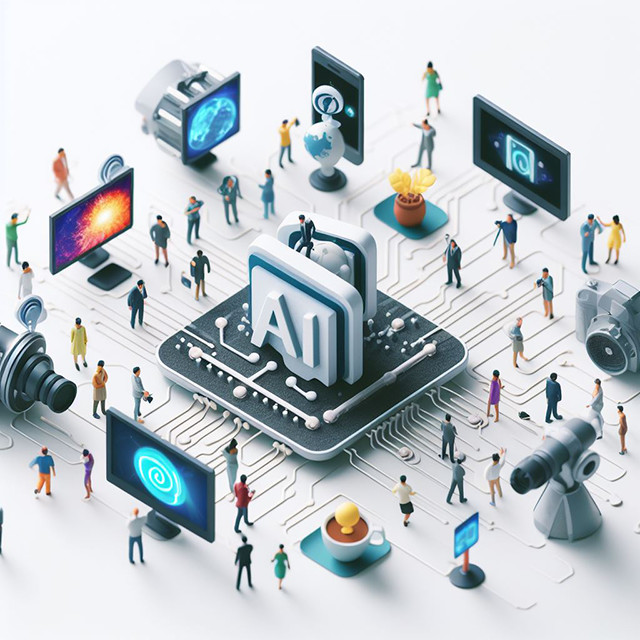Reinforcement Learning: Principles, Algorithms, and Applications in Barcelona
Reinforcement Learning with AI
Reinforcement learning is a type of machine learning where an agent learns how to behave in an environment by receiving positive or negative feedback for its actions. The goal of reinforcement learning is for the agent to determine the best actions to take in order to maximize a reward. It is inspired by behavioral psychology and allows systems to automatically determine the ideal behavior within a specific context to maximize performance. Reinforcement learning has become an important technique in training AI systems.
In reinforcement learning, the agent interacts with the environment by taking actions and observing the results. The actions affect the state of the environment, and the agent receives rewards or penalties based on the results. The agent seeks to maximize the total rewards received over time by learning which actions yield the greatest rewards in which states. This enables the agent to determine the optimal behavior through trial and error interactions with its environment.
There are three main components in reinforcement learning: the agent, the environment, and the reward function. The agent is what takes actions, the environment is what the agent interacts with, and the reward function provides feedback on the agent's actions. The goal of the agent is to develop a policy, or a mapping from states to actions, that maximizes the rewards received.
There are several key elements that make up the reinforcement learning process:
- States: The states describe what is going on in the environment. They provide the current situation to the agent. For example, in a game of chess, the state would contain the positions of all the pieces on the board.
- Actions: The actions are what the agent can do. For chess, actions would include legal moves for each piece. The agent needs to determine the best action for each state.
- Rewards: The rewards provide feedback to the agent on how good or bad an action was. Positive rewards encourage the agent to repeat actions, while negative rewards discourage actions. Maximizing long-term reward is the overall objective.
- Environment: The environment is what the agent interacts with. It receives the agent's actions and responds by moving to a new state and giving the agent a reward.
- Policy: The policy is the agent's strategy for which actions to take in each state. The goal of reinforcement learning is to determine the policy that maximizes rewards.
There are several algorithms used in reinforcement learning:
- Dynamic programming algorithms like policy iteration and value iteration that iteratively evaluate and improve policies and value functions.
- Monte Carlo methods which directly sample episodes of experience to evaluate policies.
- Temporal difference learning which learns from partial episodes and bootstraps estimates from other estimates. Q-learning is a popular temporal difference method.
- Deep reinforcement learning combines deep neural networks with reinforcement learning to develop policies and value functions approximated by neural nets.
Reinforcement learning has been applied successfully in many domains such as games, robotics, resource management, finance, and more. It is widely used to train AI systems to excel at games. One famous example is DeepMind's AlphaGo program which became the first to defeat a professional Go player using reinforcement learning combined with neural networks. Self-driving car systems also employ reinforcement learning to optimize driving policies.
There are two main forms of reinforcement learning:
- Value-based reinforcement learning focuses on estimating value functions that measure long-term reward. Algorithms like Q-learning are value-based methods.
- Policy-based reinforcement learning works by directly modeling optimal policies. Policy gradient methods are examples of direct policy modeling.
Value-based vs policy-based methods represent a tradeoff between quality of solutions and ease of use. Value methods focus on finding optimal actions, while policy methods focus on end-to-end policy optimization.
Model-free and model-based reinforcement learning are another dichotomy in approaches. Model-free methods like Q-learning work without modeling the environment's dynamics. Model-based methods explicitly model the environment and can be more sample-efficient. However, modeling is complex for most real-world problems.
There are also different criteria for measuring the optimality of a policy:
- Finite-horizon seeks to maximize reward over a fixed sequence of steps.
- Infinite-horizon maximizes long-term reward over an indefinite number of steps.
- Average-reward optimization maximizes average per-step reward.
- Discounted-reward uses discount factors to value near-term rewards higher than distant rewards. This is the most common setting.
Challenges in reinforcement learning include dealing with limited training data, large state/action spaces, and balancing exploration vs exploitation. Key methods to address these include experience replay, function approximation, and techniques like upper confidence bounds.
Deep reinforcement learning has emerged as a powerful approach combining deep neural networks with reinforcement learning. Deep networks can approximate the policy and value functions, letting agents learn directly from raw, high-dimensional inputs like images. Deep RL enabled breakthroughs in playing games like Go, Atari video games, and motor control problems.
Key algorithms in deep reinforcement learning include:
- Deep Q-Networks (DQN): Uses neural nets to represent the Q-value function for Q-learning. DQN mastered a range of Atari games.
- Policy Gradients: Optimizes policies modeled by neural nets by directly adjusting network weights to maximize rewards.
- Actor-Critic Methods: Uses one neural net to approximate the policy (actor) and another for the value function (critic). The critic provides feedback to guide the actor's learning.
- Model-Based RL: Uses neural nets to model the dynamics of the environment for more efficient learning.
- Multi-Agent RL: Extends deep RL to environments with multiple learning agents. Open research problems remain in optimal coordination.
- Hierarchical RL: Uses hierarchies of policies or value functions operating at different timescales. Helps tackle long-term credit assignment.
Active areas of research in deep reinforcement learning include improving sample efficiency, multi-task learning, transfer learning, model-based methods, hierarchical architectures, and multi-agent systems. There are also efforts to increase the explainability and interpretability of deep RL agents.
Reinforcement learning offers a framework for training AI agents to perform robustly in complex environments. It holds great promise for advancing AI capabilities in real-world domains like robotics, autonomous vehicles, medicine, finance, and more. With further advances in algorithms and compute power, reinforcement learning will drive the next generation of intelligent systems that can make good decisions and take optimal actions based on their experience interacting with dynamic environments. The combination of reinforcement learning and deep neural networks provides a powerful approach to developing sophisticated AI systems that keep improving with more data and experience.
Reinforcement Learning Applications in Barcelona
Barcelona has emerged as a growing hub for artificial intelligence research and development. With its thriving technology sector and top universities, Barcelona is home to numerous projects applying reinforcement learning to tackle real-world problems.
RL is being implemented in a variety of ways in Barcelona. Here are a few examples:
-
Robotics: RL is being used to train robots to perform complex tasks, such as
walking, navigating, and manipulating objects. For example, researchers at
the Barcelona Centre for Computer Vision (CVC) are using RL to train robots
to walk over rough terrain and to perform tasks such as picking up and
placing objects.
Another example is a recent study published in Science Robotics that demonstrates Barcelona's leadership in artificial intelligence by showcasing how researchers from the Institute of Marine Sciences (ICM-CSIC) and collaborating universities developed reinforcement learning techniques to optimize underwater object tracking by autonomous robots. As detailed in the article, by training neural networks to identify ideal vantage points and trajectories, the project proved reinforcement learning's ability to master complex real-world robotics challenges like monitoring marine animals along the seafloor. - Self-driving cars: RL is being used to train self-driving cars to navigate roads safely and efficiently. For example, researchers at the Centre for Automation and Robotics (CAR) at the Polytechnic University of Catalonia (UPC) are using RL to train self-driving cars to navigate intersections and to avoid obstacles.
- Energy management: RL is being used to develop energy management systems that can optimize the use of renewable energy resources. For example, researchers at the Institute for Energy Research (IREC) are using RL to develop a system that can optimize the charging of electric vehicles.
- Healthcare: RL is being used to develop new treatments for diseases and to improve the efficiency of healthcare systems. For example, researchers at the Hospital Clínic de Barcelona are using RL to develop a treatment plan for patients with type 1 diabetes.
Here are a few specific examples of companies and research institutions in Barcelona that are implementing RL:
- Pal Robotics: Pal Robotics is a company that develops and manufactures robots. Pal Robotics is using RL to train its robots to perform tasks such as walking, navigating, and manipulating objects.
- Waymo: Waymo is a self-driving car company. Waymo is using RL to train its self-driving cars to navigate roads safely and efficiently.
- Acciona: Acciona is a company that provides energy and infrastructure services. Acciona is using RL to develop energy management systems that can optimize the use of renewable energy resources.
- Hospital Clínic de Barcelona: The Hospital Clínic de Barcelona is a research hospital. The Hospital Clínic de Barcelona is using RL to develop new treatments for diseases and to improve the efficiency of healthcare systems.
The future directions of reinforcement learning research and development are exciting:
- Multi-agent reinforcement learning: Developing reinforcement learning algorithms that can train multiple agents to cooperate and achieve common goals. This is important for real-world applications such as self-driving cars and robotics, where multiple agents need to work together safely and efficiently.
- Hierarchical reinforcement learning: Developing reinforcement learning algorithms that can learn complex tasks by decomposing them into smaller, simpler subtasks. This can make reinforcement learning more scalable and efficient for real-world problems.
- Deep reinforcement learning: Combining reinforcement learning with deep neural networks to enable agents to learn from high-dimensional inputs such as images and text. This has already led to breakthroughs in games and robotics, and has the potential to revolutionize other domains as well.
- Explainable reinforcement learning: Developing reinforcement learning algorithms that are more transparent and interpretable. This is important for understanding how reinforcement learning agents make decisions and for ensuring that they are behaving in a safe and ethical manner.
If you want to learn more about Reinforcement Learning check Deep Reinforcement Learning Explained in Medium by Prof. Jordi Torres from UPC
Overall, reinforcement learning is a rapidly evolving field with the potential to revolutionize many industries and improve our lives in many ways. Barcelona is at the forefront of this research, and we can expect to see even more innovative and groundbreaking applications of reinforcement learning in the years to come.



Comments
Post a Comment